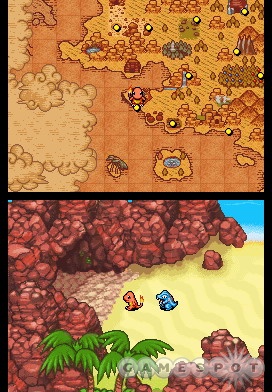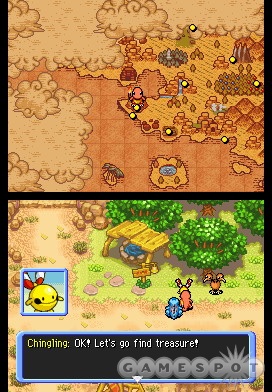The Mystery Dungeon series from Chunsoft has been catering to fans of two-dimensional role-playing games for years. The games offer random dungeons, plenty of items to collect (though rarely enough space to carry them), clumsy turn-based combat, and a degree of challenge that often forces you to retry the same levels over and over again before you're successful. With Pokemon Mystery Dungeon: Explorers of Darkness and Explorers of Time, the Nintendo DS is getting two versions of its second Mystery Dungeon entry this year. Although these offerings take steps to make the dungeon-hack trappings more accessible than last month's Mystery Dungeon: Shiren the Wanderer, they still feel monotonous and are too similar to 2006's Pokemon Mystery Dungeon games to warrant much attention.
Explorers of Darkness and Explorers of Time break the Mystery Dungeon mold by providing you with a hometown and a central guild to which you can return. Game progress is broken down into a combination of routine daily missions and story-based missions, and some plot exposition is given after you complete each. You can also save your progress between missions and take care of your Pokemon in the event that it's hungry. Consequently, making your way through these games is nowhere near as brutal as you might expect if you're familiar with their predecessors.

The lower challenge level here definitely has its advantages. For starters, you're less likely to give up in frustration before you've had a chance to enjoy the interesting plot, which has some genuinely touching moments. As in the previous Pokemon Mystery Dungeon games, you start off as an amnesiac human who has been mysteriously transformed into a Pokemon. You soon encounter and partner with a friendly Pokemon, and together you decide to join an explorers guild. Soon, you learn of a world threat that somehow involves the very fabric of time itself. The one glaring issue with the game's story presentation is the unforgivably redundant dialogue. More often than not, your Pokemon's thoughts are visible as text before it actually chooses to voice them, at which point it repeats almost word for word what you've already read.
The redundancy in the dialog is mirrored in some of the missions that you embark on. Almost every mission involves rescuing a stranded Pokemon or arresting an outlaw Pokemon. There are some item and escort requests, but they all play out in much the same way: delving into a dungeon and going through generic, randomly generated floors until you find the object of your search. Even the story-based missions play out in this way, with the one difference being that the dungeons during these experiences are much longer, provide a few save points in-between floors, and are often capped off with a boss battle.
Most of the battles you encounter, including those against boss characters, help allay the repetitiveness and blandness of the dungeons, though not greatly. The gameplay feels only slightly less clumsy and plodding than that of its Mystery Dungeon predecessors, because every action you take, whether it's taking a step, attacking, or equipping an item, still counts as a turn. Given that all combat takes place on a map screen presented in the top-down perspective, you'd be forgiven for thinking that the experience would mimic something like the classic Zelda games; instead, you get a clumsy back-and-forth experience that stalls as you wait for every creature to complete its turn.
However, a few Pokemon franchise additions come to save the day. You can recruit Pokemon you've defeated into your party, and any recruits that exceed your four-member party limit will be sent back to the guild on standby. Each of your party members can learn up to four special moves; and as they level up, they will have the opportunity to forget an old move and learn a new one. So, you're occasionally--if not constantly--getting the opportunity to try out new tricks and abilities against your foes. You can also set the behaviors of all of your Poke-compatriots to do things such as avoid trouble, take an aggressive stance, or consciously refrain from special moves that might be useless in a certain situation. These battle options, as well as the various items you gather, create a nice variety of tactics to draw on when fighting large groups of enemies or threatening boss characters.
Of course, there's also the plethora of familiar Pokemon creatures available for you to discover, and they're all represented in vibrant colors and smooth animations. Nevertheless, it's a shame that the visual presentation isn't more consistent. The set pieces for the town, your guild, and key areas in the story-based dungeons are drawn in a soft, whimsical cartoon style with rich coloring. This is all matched in whimsy by the well-composed, youthful soundtrack, which boasts crisp, varied instrument samples. However, as soon as you step into a dungeon for a mission, you're greeted with a heaping face-full of boredom. Repetitive visuals lack detail and employ wholly uninteresting color schemes, making dungeons look almost monochrome and making the combat seem even more like drudgery than it actually is.
At least dying in this game doesn't set you back and have you feeling like a newborn every time. But even if you do kick the bucket, you can ask to be rescued from mission dungeons by another player, though it's worth mentioning that this option isn't available in some of the story-driven levels. For a rescue to work, you'll need for a potential rescuer to have visited the same dungeon and floor on which you've expired. Calling for help is as simple as choosing to request a rescue after fainting, then going to the appropriate menu in the title screen before logging into the Nintendo Wi-Fi Connection, and sending a text message along with your rescue request. (Alternately, you can do this by using the wireless communication between two Nintendo DS systems, or with a cumbersome 54-character password.) However, Chunsoft has one-upped its previous Wi-Fi efforts: Not only can you now send jobs that you've accepted to a friend with the Nintendo Wi-Fi connection, but you can also send rescue requests to someone's e-mail address or mobile phone. In the absence of knowing when your friends will actually be playing the game, this is a great boon if you just need a quick pick-me-up.

If you're at all familiar with the Pokemon franchise, then it'll come as no surprise that unless you play both the Explorers of Time and Explorers of Darkness versions, you won't be able to meet and recruit all of the Pokemon in Mystery Dungeon's story. However, this doesn't make a huge difference when playing through the game. The variety of move sets and resulting tactics between the two games doesn't feel substantially different enough to warrant playing through both versions, and the presence of exclusive items doesn't add a great deal either.
In any event, one version of this Pokemon Mystery Dungeon entry should suffice. You'll get more than 20 hours of gameplay from front to back, and that doesn't include the extra hours that you'll spend leveling up or restarting after a game-over screen. There are plenty of optional missions to embark on as well, even after you've completed the story. If you found the previous Pokemon Mystery Dungeon game disappointing and would rather just catch 'em all as a Pokemon trainer, then this won't likely change your mind. Chunsoft's Mystery Dungeon formula is showing its age with jittery combat and bland dungeons, but these games still offer a decent balance of challenge, story, tactics, and Wi-Fi innovations to keep patient players entertained.